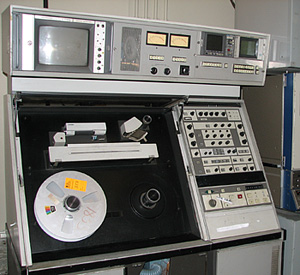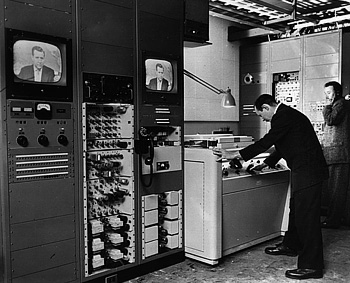Videotape is Not Dead, Either
Part I
You have previously read in this column that despite several memorial services, film is not dead as a capture medium for television programming. In fact, after some flirtation with 24 fps video, we are back to the situation in which almost all dramatic programming for television is shot on film.
At this juncture, there are those who are preparing memorial services for videotape, but this also seems premature. I well remember a capable and respected television engineer telling me in the early 1990s that, "We can't afford videotape anymore." In fact, it is still a relatively inexpensive and trouble-free way to store and transport video. Let's take a brief look at the history of this medium, and prognosticate on its future.

Ampex AVR-1, a 2-inch videotape machineVIDEOTAPE REWIND
The commercial use of videotape was born in 1956, when the Ampex Corp. developed and sold 2-inch quadruplex video recorders, and soon was followed by RCA, who quickly added composite color (NTSC, in the case of the United States.). The four heads of the quadruplex scanner scanned the tape transversely or "in quadrature," that is, perpendicularly to the long dimension of the tape. Quad machines also used compression, but not the type of compression you are thinking of. They used compressed air to form an "air bearing" to properly position the tape as it travelled through the head assembly.
Previous attempts at video recording had used stationary heads, as in audio recording, but this required the tape to move across the stationary head at very high speed, using huge amounts of tape stock and requiring very large reels. Two-inch quad was the first video recording technology in which the heads themselves moved, being mounted on a spinning scanner, which generated head-to-tape speed sufficiently high to record the required bandwidth, while permitting the tape's longitudinal speed to be reasonably slow, conserving tape stock. Even so, an hour-long reel of 2-inch quad tape is rather large and heavy, to say the least.
The 2-inch quad machine bore some strong resemblances to its audio tape recording predecessors. It essentially used 2-inch audio recording tape as its recording medium. Like open-reel audio recording tape, quad tape was quite thick and rigid compared to any of its successors. It even ran at a linear speed of 15 inches per second, which is an analog audio recording tape speed. Because of its thickness and rigidity, it was not nearly so subject to the varying time base errors which are characteristic of 1-inch recording and its successors.
Two-inch video recording is done in a segmented fashion, each track on the tape representing one-sixteenth of an NTSC field. While the video quality is very good, the segmented footprint on tape meant that this format could not have the "stunt modes" that the 1-inch formats, in which each track on tape represents an entire video field, have. These stunts include such things as variable speed and reverse playback. For a number of years, editing on 2-inch tape was done mechanically, with a razor blade. This obviously required the development of some degree of skill. In later years, electronic editing systems were developed for the 2-inch format.

CBS was the first to use the new videotape technology for time shifting of its New York-based programming in 1956. Two-inch video recording machines were physically very large, containing a large amount of electronics, much of it tube electronics. They required considerable regular maintenance by skilled technicians to keep them performing well, and skill was required of their operators as well.
In addition to the 2-inch reel-to-reel machines, both Ampex and RCA developed 2-inch quadruplex video cartridge machines for commercial playback, and if you think 2-inch open reel machines look so complicated that it would be impossible for them to actually work, take a look at one of the cartridge machines!
U-MATIC VIDEO RECORDING
In spite of the drawbacks, the 2-inch quadruplex video recorder era, the first generation of video recording, lasted from 1956 until the late 1970s, when broadcast quality 1-inch video recorders made their appearance on the scene. This era, more than 20 years, was by far the longest that any generation of video recording enjoyed. Its successor, 1-inch, lasted only about half as long.
To make the record complete, we need to acknowledge the three-quarter-inch U-matic video recording format, the first cassette-based format. U-matic was initially developed as a consumer video recording format, but it never caught on with consumers.
It appeared on the scene around 1970, and its relatively small size and cassette-based format made it a natural for newsgathering and other such portable applications. Its principal flaw was that its video was not really broadcast quality. In spite of this, and the fact that higher quality could be achieved by a number of subsequent, smaller, cassette formats, U-matic has enjoyed a very long life. In fact, it is still being used to some extent for nonbroadcast applications, such as distribution of review copies of programs, although this type of application is largely being taken over by DVDs today.
As its name implies, the format uses three-quarter inch oxide tape in a cassette. Its limited bandwidth, around 2.5 MHz, not only delivers low luminance resolution, but it is also insufficient to permit the recording of composite color. Instead, it employs a "color under" system, wherein the chrominance signals are modulated onto a subcarrier that is lower in frequency than the luminance signal, and it delivers significantly lower chroma resolution than is achieved with composite color, in which the color subcarrier is interleaved with the luminance signal. This is, by the way, the same way that the VHS format works, although VHS is recorded on half-inch tape, so its bandwidth is even lower. And yes, for those Betamax fans in the audience, the Betamax format works the same way, too.
For high-quality professional video recording, 2-inch quadruplex was, in the late 1970s and early 1980s, supplanted in the United States by the 1-inch Type C video recording format. While 1-inch helical-scan recording had been around for a while before this, its use was limited to monochrome industrial applications, because the thin, stretchy tape stock it requires gave rise to serious, varying time base errors that made successful color playback virtually impossible until the digital time base corrector, probably the first widely-used digital video device, appeared.
When this finally happened, broadcast quality 1-inch machines were developed. These were physically much smaller than 2-inch machines, though still quite large by current standards. They also offered the capability to do stunt modes, and delivered, "90 percent of the quality of 2-inch at 50 percent of the price." In the future, we will take a closer look at 1-inch recorders, and their successors in the video recording field.
Get the TV Tech Newsletter
The professional video industry's #1 source for news, trends and product and tech information. Sign up below.

